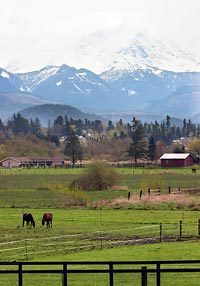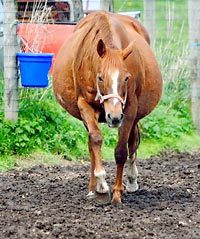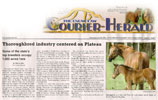

Connect with us... |
| In The News | |||||||||||||||||||||||||||||||||||||||||||||||||||||||||||||||||||||||||||||||||||||||||||||||
Outofthebluebell, Dam of Rings a Chime, Dies: Griffin Place's Outofthebluebell (Red Ryder--Natchez Bluebell, by Star Envoy), the dam of 2000 GI Ashland S. winner Rings a Chime (Metfield), died from the complications of a strangulated small intestine Aug. 23, 2007. The Illinois-bred mare was 22 years of age. A stakes winner of $195,966, Outofthebluebell is the dam of six winners from eight to make the races, highlighted by Rings a Chime, who was also runner-up in the GI Kentucky Oaks. She has since gone on to star in the sales ring, having produced $3.1-million FTSAUG yearling Black Cat Crossing (Storm Cat). Outofthebluebell was to be cremated and buried at the farm. View PDF... 8/9/07 Plateau Thoroughbred breeders and friends Mary Lou Griffin of Griffin Place and Debbie Pabst of Blue Ribbon Farm flew to Hollywood Park in California July 14 to watch a special race. The two Buckley residents, who own breeding farms next door to each other, watched their 3-year-old colt Chancellor win his first race by a nose in a 1-1/16-mile maiden special weight on the turf. Horse Racing | Bridging "The Gap" In 1991, Mary Lou and Terry Griffin decided to get firmly
established in something many Washington state Thoroughbred breeders were abandoning: breeding horses. The Griffins stopped the traveling that had been a part of Terry's construction work, bought some mares at the Keeneland sale in Kentucky and put down roots on their farm near Buckley. "We decided to buck the trend," said Mary Lou in a profound understatement. Thoroughbred breeders in the state at the time stood on one side of what those in racing now refer to as "the gap." Most of the breeders could not see any hope of getting to the other side or if there even was an other side. "The gap" was the time between 1992, when the Longacres track in Renton closed, and 1996, when Emerald Downs opened in Auburn. The number of state foals fell from 1,839 in 1990 to 1,110 in 1995, and the breeding industry hasn't been the same since. Emerald Downs' 2007 season opens tonight with 1,070 horses on the grounds, 585 of them Washington-bred (55 percent). The first race tonight had been planned for Washington-bred horses only. But only five such horses were entered. Four horses from elsewhere will join the Washington five for a nine-horse field. Emerald Downs opening day: Today, first post 6 p.m. Home-bred and homegrown horses have been the main supply of animals for the state's racing industry. Without them, more horses have to be brought in from elsewhere, which means more expense in a sport with fragile economics already. In 2004, the number of foals born in Washington was down to 677, representing 2 percent of the Thoroughbreds born in the United States that year. In 1985, the state breeding business produced 2,251 foals, almost 5 percent of the national crop. "Without the Washington-breds, horses would come from Oregon, California and maybe back East," said Frank McDonald, president of the Horsemen's Benevolent & Protective Association, "but we'd be traveling for sales [to buy horses], and it would be a lot more expensive."
Speaking at a meeting of the Washington Horse Racing Commission last week, McDonald said a solution to turn around the downward trend in the breeding industry "can't be years down the road, or Washington's horse-breeding industry will cease to exist and eventually horse racing will follow." "The gap" doesn't take all the blame for the exodus of Washington breeders. There's also the closing of Yakima Meadows and Spokane's Playfair tracks in the late 1990s. "With less racing there is less demand for horses," said Robert Leichner, executive secretary of the state racing commission. "Before, a breeder could pick up some breeder awards from Longacres, then move on to Playfair in Spokane and Yakima Meadows. "Now those opportunities are gone." In 1992, there were 277 days of racing in Washington state. Starting tonight, Emerald Downs offers 91 dates this year, and four small racetracks in the Blue Mountain Racing Circuit will have 19 days of racing at Southeastern Washington fairgrounds. "Playfair and Yakima Meadows didn't make anyone rich," said McDonald, "but it kept breeders in business." For many years after the Legislature legalized parimutuel betting on horse racing in 1933, there wasn't much competition for the gaming dollar. In fact, there wasn't much competition for the sports/entertainment dollar. "There wasn't professional football, professional baseball, professional basketball, soccer," said Ralph Vacca, general manager for the Washington Thoroughbred Breeders Association. "All those things are not a necessarily bad thing ... but horse racing was no longer the only game in town." Then came competition for the gaming patron. First the lottery, then tribal casinos and non-tribal casinos — "each a blow in the arm," according to McDonald. To encourage breeding in the state, the racing law provides for awards for owners and breeders of Washington horses. And it calls for at least one race of each day's meet to be exclusively for Washington-bred horses. But a March racing commission report noted that "no one interviewed could recall when, if ever, the goal of one Washington-bred race per day was achieved" in the past six years. According to the report, the average number of race dates in those years was 92 with 58 Washington-bred races per year. Speaking at the racing commission meeting last week, Emerald Downs president Ron Crockett said there were tradeoffs between supporting the breeders and attracting sufficient wagering. The track could offer Washington-bred races with fewer horses, but races with small fields do not attract as much betting interest. The amount of wagering determines the size of the purses, which ultimately dictate the size of the awards and bonuses to owners and breeders of state horses. Seven horses in a race seems to be the magic number to attract bettors to play a race, and Emerald Downs has an agreement with the horsemen's association that it can cancel most races with fewer than seven entries. "It all swirls around purses," Crockett said. "That's the heart of it. You strive the best you can to increase purses to generate bonuses." Last year, 211 breeders shared $696,892 in awards for first-place finishes by Washington-bred horses. This year, the bonuses will be spread out with breeders of winning horses getting 75 percent, second place qualifying for 15 percent and show horses getting 10 percent. Will spreading out the awards save breeders? "Probably not alone," said Vacca, whose breeders' organization has gone from 1,500 members in 1980 to about 500 this year, "but it will expand the number of breeders who could get some of the money. It might be enough to pay the hay bill or something else, and it may be enough for the breeder to say, 'I'll stay around for another year.' " It's not all gloom and doom. On her 70-acre farm, Mary Lou Griffin said, "I hope we are at the bottom of a trend and that we will start to see more mares in the state." She might be right: In 2005, the Washington foal crop increased to 710, holding steady at 2 percent of the national Thoroughbred class. And Griffin thinks the industry "skinnied down and got better." "We're breeding nationally, and the winning percentage for Washington-bred horses has been consistent," he said. "We have a better product with fewer horses." The year 2011 offers hope to some breeders. That's when a concession by the owners and breeders will conclude. Under the agreement, which helped pay for the construction of Emerald Downs, the owners agreed to give up half of their awards and the breeders 25 percent for 15 years. "A return to the larger amounts will do a lot to encourage breeding and owning Washington horses," Griffin said. But Crockett is cautious. "It would be extremely difficult for us financially,"
he said. "It's not germane right now. It's still four years
away, and we'll have to see what happens to the industry."
A quick inventory of farms on the Plateau include Mary Lou and Terry Griffin's farm, Griffin Place in Buckley. Read the entire story [pdf]... [top] |
|||||||||||||||||||||||||||||||||||||||||||||||||||||||||||||||||||||||||||||||||||||||||||||||
| 2007 Past Entries | |
| 2006 Past Entries | |
| 2005 Past Entries | |
| 2004 Past Entries | |
| 2003 Past Entries | |
| Copyright © Griffin
Place 2002 -
Contact Us! |
|



